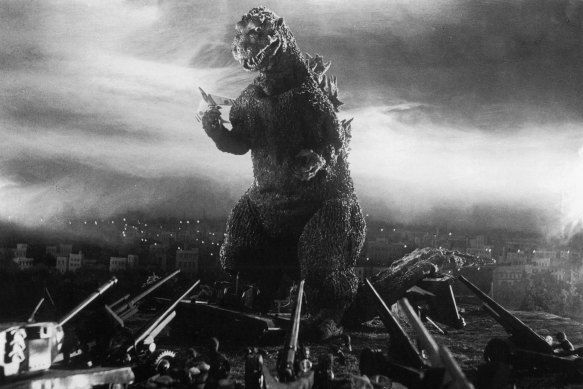
Seventy years ago, a mighty roar reverberated throughout cinema for the first time. This roar was accompanied by a deadly beam of radioactive breath, and the pounding footsteps of a beast bent on destruction.
Godzilla, the ruler of monsters, was born.
Since first appearing in Ishirō Honda’s 1954 film Gojira, which saw the reptilian titan wreak havoc on post-war Tokyo, Godzilla has featured in 38 Japanese and US-made films. The most recent instalment, Godzilla x Kong: The New Empire, grossed nearly $851 million worldwide – overtaking Kong Skull Island (2017) to become the highest-grossing movie in the Warner Bros and Legendary Entertainment “Monsterverse” series.
Godzilla’s reign now extends to a four-day festival at Melbourne’s ACMI, GodzillaFest, with waitlists forming more than a month before the opening on Thursday.
Godzilla has inspired countless comic books, TV shows, and video games, as well as a giant Godzilla bust in Tokyo’s Kabukicho district. In March, it even earned its first Academy Award, when Takashi Yamazaki’s Godzilla Minus One won for best visual effects.
“It’s been 70 years, but Godzilla is perhaps more relevant today than ever,” says Seb Chan, chief executive of ACMI. “Parents and grandparents grew up around Godzilla, and now younger generations are discovering it too. Godzilla is a cinematic icon.”
Loading
Godzilla has come in many forms, and fought many foes, over its seven decades. With the Godzilla x Kong sequel slated for 2027, it clearly isn’t slowing down. Let’s explore how this atomic creature has stood the test of time and earned its spot on the monster throne.
More than a monster
As entertaining as it is to watch Godzilla annihilate cities, its long legacy comes down to its symbolism.
“Godzilla is a moral monster,” says Jason Jones, a Japanese Studies lecturer at Monash. “It usually appears because of something humans have done that threatens their own existence. It forces us to consider how we exist in the world, and how humans coexist with one another.”

Gojira (1954) was the first in the Godzilla franchise, which has been going strong for 70 years and counting.Credit: Toho Co.
The 1954 iteration represented the impact of nuclear bomb testing in the Pacific. The reckless use of nuclear weapons mutated Godzilla into something monstrous and vengeful – a beast that destroys the progress made in post-war Tokyo.
Since then, Godzilla has become a metaphor for climate change and environmentalism, says Silvi Vann-Wall, a podcaster and filmmaker who is leading several GodzillaFest panels. In 2016, Shin Godzilla represented the 2011 Fukushima Daiichi Accident, and Japan’s frequent tsunamis.
“The way the [fictional] government responds to – or rather, hems and haws about – Godzilla has lots to say about modern bureaucracy,” Vann-Wall says. “The meaning of Godzilla shifts because we always have something new to be afraid of as society evolves.”

Silvi Vann-Wall will lead several panel talks at ACMI’s GodzillaFest, where they will explore the creature’s lasting legacy in cinema and pop-culture.Credit: Jason South
Cinematic and pop-cultural icon
Godzilla has been referenced in The Simpsons and South Park, has been used in ads for KFC and Jeep, and has inspired songs by artists such as Eminem. It even inspired other films, including Pacific Rim and Steven Spielberg’s Jurassic Park.
“Godzilla is a spectacle. You don’t need to see it to know it’s coming. This instant recognisability helps its ongoing appeal,” Jones says.
There’s a sensitive side to the humour and terror Godzilla represents. The creature has become a global and intergenerational icon because of its relatability.
“A lot of us feel monstrous in our own bodies,” Vann-Wall says. “There’s a traceable history of ‘misfit’ folk relating to monsters in movies because we also fall on the fringes of society and are often cast out … We feel that, ultimately, the monster is just misunderstood.”
The earlier films are some of the most famous examples of double-speed filming and “suitmation”, the technique of using a full-sized suit to portray a non-human character. Sophia Staite, a tokusatsu (live-action films that rely on practical special effects) expert at The University of Tasmania believes this is making a comeback.

“The monster is just misunderstood”: Silvi Vann-Wall at ACMI’s GodzillaFest.Credit: Jason South
“For example, the Demogorgon in Stranger Things. We may be entering a period of CGI fatigue after the long domination of Marvel films. Practical special effects can be enhanced with CGI to give a feeling of grounding and tangibility, as we’ve seen with Godzilla.”
Godzilla’s future
Loading
One of Godzilla’s enemies could return, Vann-Wall suggests, such as Mechagodzilla, a robotic Godzilla introduced in the ’70s.
“That could be a metaphor for our fears surrounding generative AI. Godzilla could be fighting on behalf of humanity to take down Mechagodzilla, who has been programmed to scan and recreate every human as perfect robot versions of themselves.”
As long as humans exist, Jones doesn’t see Godzilla going anywhere.
“No matter how humans are messing up at the time, whatever disasters or geopolitical situations we find ourselves in, it will be represented in a Godzilla film.”
GodzillaFest will run at ACMI from October 31 to November 3, and will include both free and ticketed events.
Find out the next TV, streaming series and movies to add to your must-sees. Get The Watchlist delivered every Thursday.









 Add Category
Add Category